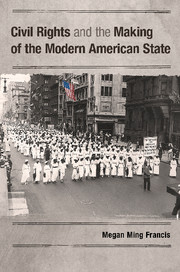Book contents
- Frontmatter
- Dedication
- Contents
- List of Figures and Table
- Illustrations
- Acknowledgments
- Abbreviations
- 1 Rethinking Civil Rights and American Political Development
- 2 The Birth of the NAACP, Mob Violence, and the Challenge of Public Opinion
- 3 The Unsteady March into the Oval Office
- 4 Anti-Lynching Legislation and the Sinking of the Republican Ship in Congress
- 5 Defending the Right to Live
- 6 Civil Rights Bound
- Appendix Manuscript Sources
- Bibliography
- Index
- References
2 - The Birth of the NAACP, Mob Violence, and the Challenge of Public Opinion
Published online by Cambridge University Press: 05 June 2014
- Frontmatter
- Dedication
- Contents
- List of Figures and Table
- Illustrations
- Acknowledgments
- Abbreviations
- 1 Rethinking Civil Rights and American Political Development
- 2 The Birth of the NAACP, Mob Violence, and the Challenge of Public Opinion
- 3 The Unsteady March into the Oval Office
- 4 Anti-Lynching Legislation and the Sinking of the Republican Ship in Congress
- 5 Defending the Right to Live
- 6 Civil Rights Bound
- Appendix Manuscript Sources
- Bibliography
- Index
- References
Summary
Our country’s national crime is lynching.
– Ida B. Wells, 1900He who attacks lynching attacks one of the oldest, one of the most deeply rooted of the institutions peculiarly American, one eminently respectable in origin, which is regarded by its adherents, not as in opposition to the established laws, but rather as a supplement to them – a species of common law which is as old as the country.
– Roy Nash, 1916The National Association for the Advancement of Colored People (NAACP) boldly declared, “Lynching can be stopped when we reach the heart and conscience of the American people.” In the beginning, the NAACP viewed the fight against lynching as a moral struggle “of the brain and the soul and to the brain and the soul of America.” In order to wage a battle against negative public perceptions in the first quarter of the twentieth century, the NAACP launched an expansive public education media campaign where the organization investigated lynchings, wrote newspaper articles, published pamphlets, and printed its own magazine, The Crisis. The NAACP’s initial exposure-focused strategy was predicated on the belief that white Americans would become so enraged that they would feel compelled to do something to end the tragedy of racial violence. Today, looking back, it seems unlikely that the NAACP would conceive that a solution to the deepest problems that Americans faced to equal citizenship would come about through trying to change public opinion alone. But they did, revealing that “public opinion is the main force upon which the Association relies for a victory of justice” not political or legal advances. Even NAACP director of publicity and research W. E. B. Du Bois expressed his initial conviction that appealing to the hearts and minds of Americans would end lynching when he wrote, “I regarded it as axiomatic that the world wanted to learn the truth and if the truth was sought with even approximate accuracy and painstaking devotion, the world would gladly support the effort. This was, of course, but a young man’s idealism, not by any means false, but also never universally true.” Indeed, Du Bois and the rest of the NAACP would soon realize the limits of a movement aimed at reaching the “soul of America” and the resulting need to engage the federal government in preventing racial injustices at the state level.
- Type
- Chapter
- Information
- Civil Rights and the Making of the Modern American State , pp. 29 - 58Publisher: Cambridge University PressPrint publication year: 2014



